Facts about Compound Bows
Table of Contents
The riser is the central part of the compound bow, and it includes limbs, sights, stabilizers, and quivers. It’s also why it’s constructed of aluminum, magnesium alloy, or carbon fiber to keep its form as stable as possible. Limbs are built of composite materials because they must be flexible yet not break under the energy stored to shoot the arrow (speeds of arrows fired from compound bows can reach from 46 to 113m/s). Plastic-coated steel was used to make the bowstrings and cables of a compound bow for the first time. Today, high-modulus polyethylene is utilized and created to provide excellent tensile strength while minimizing expansibility to allow the bow to transfer all of its energy to the arrow without loss.
The arrows used for compound bows do not differ much from those used with other types of bows. They are made of carbon fiber, aluminum alloy, or a combination of these two materials. They only have different “spine.” The spine of the arrow reflects how stiff it is, and, for example, an arrow with a more spine bends less. The spine (of the arrow) is reduced in a compound bow when compared to a recurve bow because the compound bow accelerates an arrow more gently and linearly. Wooden arrows are avoided because a compound is too powerful for them. This can break them and injure the archer as well.
The benefits of a compound bow include the fact that it stores more energy and shoots faster than other bows of the same size. The acceleration of the arrow can be controlled by the cam’s design and creating different bows for different archers; The way it works, it can be designed with horizontal limbs that reduce recoil and vibration and make the bow more accurate. The temperature and humidity levels do not affect its performance. It is accurate at all times. This bow is typically used by archers who utilize a mechanical release aid to hold and then let go of the string to ensure more consistent releases. They also use a sighting system, consisting of a back sight and a front sight, to help them aim.
There are certain disadvantages to using a compound bow. It’s a fairly complicated design with a lot of moving parts. They require more extra maintenance than other bows and create more points where a compound bow can break. When a bow is fired without the arrow (dry fire or dry loosing), it can be damaged even if only a single dry fire has been done, and warranties do not cover this damage. A special tool (bow press) that can only be found in archery pro shops is required to replace the bow string or cable. It is easier for the archer to twist the bow around the vertical axis and make left-right errors because the bow is so light.
CHARACTERISTICS OF THE RIGHT COMPOUND BOW FOR YOU

 CAM SYSTEM
CAM SYSTEM
[Updated on 1 August 2021] There are a number of compound bow cam systems (eccentrics) available in the market and innovation in the technology has more coming out every year. Common configurations are single, dual, hybrid and binary. Each cam configuration with advantage and trade-offs as well.
OVERALL WEIGHT
Heavier bows are more stable than lighter bows and are much easier to shoot accurately. Too light of a bow is likely to veer off your target every time you draw.
DRAW WEIGHT
More weight makes faster arrow speed, better trajectory, and more energy. But more weight also becomes harder to draw especially in an awkward position. If target shooting, this is not as big of a concern, but if you are hunting and need to quickly draw your bow, you may not have an accurate shot.
 BRACE HEIGHT
BRACE HEIGHT
A bow with a shorter brace height makes an arrow fly faster out of the bow, but it also makes the bow less forgiving and magnifies archer mistakes during draw and release.
AXLE TO AXLE (A2A) LENGTH
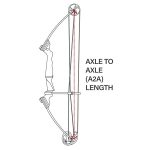
Longer bows are more accurate. Longer bows are easier to hold it steady at full draw towards a target. A2A length greatly affects the let off of the bow as well as it’s the size.
DRAW LENGTH
A draw length differs from archer to archer. To determine your ideal draw length.
- Spread your arms wide apart and measure your middle finger from tip to tip.
- Take note your arm span and divide the number by 2.5.
Fundamentals of Compound Bow
In this section, we look at the compound bow’s fundamentals. You may or may not be aware of it. We’ll go over everything from the very basics of the compound bow to the most common specifications you’ll find on bow packaging. How are they determined? What exactly do they imply? Why does this concern you? Since I was a kid, I’ve adored and respected archery. I recall seeing my father shooting his great wooden compound bow in our backyard when I was a kid. He also owned a recurve bow, but he hardly ever used it, and I always wondered why. As I grew older, I had a chance to draw both bows again.
I immediately understood why the recurve had been stowed away. Bows all work by storing energy and then releasing it. The limbs of longbows and recurve bows are used as springs to shoot arrows. The draw of the bowstring releases energy as the arrow flies. The ‘C’ form is more common among compound bows. The limbs are drawn closer together rather than away from the archer. This has several benefits.
How it Works
The Eccentric System is a mechanical mechanism used in the compound bow design. A component of this system is always a string, one or two cams, and one or two cables or harnesses. The harness is fastened to one arm of the cam and the axle on the other in a two-cam compound bow. The harness is draped over the cam and drawn towards each other as you draw the bowstring. In this situation, two harnesses are used to generate energy.
The cam’s design influences how fast your arrow travels as well as how the draw feels. You can enhance the energy stored by altering the cams’ form, which results in a quicker arrow speed. It may also modify the let-off, allowing you to hold heavier weights for longer as the target approaches. These two elements are crucial in determining accuracy and arrow penetration when using hunting bows.
The Let-off Principle
I’d like to illustrate the function of let-off by thinking of a teeter-totter (see-saw). This is a lever that sits on an axle and has two weights on each side. Lifting the weight when it gets closer to the axle is easier. Lifting becomes more difficult as the weight gets farther away from the axle. It’s the same story with a compound bow. The teeter-totter in this example has one branch that extends from the harness to the axle and another branch that extends all the way out to the bowstring.
If you pay attention to the draw of a compound bow, you’ll notice that the harness begins far away from the axle and works its way closer, while the bowstring starts close to the axle and moves further away. This is why you feel more weight at the first draw and less when you reach the full draw. It reduces shoulder strain by storing more energy in the bow with less effort. When you have the greatest mechanical advantage and maximum leverage, you’ve reached your let-off. Here’s how to figure out what draw weight is best for you.
The Back Wall
When you first test out compound bows, one of the first things you’ll notice is that each bow has a distinct feel as you reach full draw. Some people feel that they have been pinned in place and can’t go any further. Others are squishy and allow you to tug as much as you want. This all comes down to the cam’s form, specifically where it connects to the harness when you’ve reached full draw. A more flat shape will give the bow the sensation of a solid back wall. A soft round shape will give you a more mushy back wall, allowing you to keep tugging.
Draw stops are sometimes included in the bow design to ensure that the back wall is rock solid. These are pegs that are meant to touch the archer’s arm or harness. This prevents the bow from moving, giving it a solid rear wall. This is excellent news for the archer. A solid wall encourages a constant draw length when a bow designer builds one. Archery is all about maintaining a consistent level of performance. If you want to develop more precision, be consistent in your stance, draw length, and anchor location on every shot.
Arrow Speed (IBO)
We use the IBO speed rating as a reference in comparing compound bows. This is the velocity of a 350-grain arrow discharged from a 70-pound bow with a 30-inch draw length measured in feet per second (fps) using an approved chronograph.
Of course, these measurements are not always identical to the arrow weight, draw weight, and draw length that you will utilize. They do, however, provide us with a benchmark to which we may compare bows. We suggest an IBO speed of at least 300 feet per second for hunting.
A bow that can deliver a shot over 300 feet per second is considered a fast bow. Four factors influence the speed of any bow. Cam design, drawstring length from the handle to the back of the bow (brace height), draw weight, and string performance is all factors.
As was previously stated, the shape of the cam has a significant impact on arrow speed. The harder the bow feels, the more energy it has stored. The smoother and more pleasant the bow feels, the lower the energy that it stores. It’s critical to strike a balance that is both accurate and pleasant.
Brace Height
The distance between the bowstring and the rear of the handle is known as brace height. As previously said, this may have a significant impact on the speed of your arrow. The quicker your arrow travels, the shorter your brace height should be. Energy is defined as power multiplied by distance, according to physics. A short brace height allows you to put more distance between the draw and handle. This increases the amount of energy available. A brace height of seven inches is regarded as ideal by most hunters. It is difficult to manage anything less, and anything more depletes your power.
Axle to Axle Length (A2A, ATA)
The distance between the two axles when the bow is motionless is known as axle-to-axle length. For the most precise measurement, take the bow draw length with the draw weight bottomed out. According to conventional thinking, a longer A2A length is more precise than a shorter one. However, this entails using a heavier bow. Tests have shown that the difference in accuracy is minor at normal hunting and target distances. It will not make a huge difference whether you’re auditioning for the Olympics.
Draw Weight
Draw weight is the degree of resistance you will encounter as you draw back your bow string. It also has an impact on how much force your arrow will have when it leaves the bow. The draw weight of a compound bow may vary from 10 pounds for a youngster to 70 pounds for an adult. To reach vital organs, you’ll generally need at least 40 pounds of force (such as for hunting big game like whitetail deer). You should generally use a lighter draw weight if you are unsure. It will be difficult to aim accurately if you have too much weight.
Efficiency
The efficiency of a bow design refers to the capacity to replicate the energy put into a draw. To comprehend efficiency, you must consider it in terms of a comparison between the force you apply and the force your bow releases. For the actual equation, divide the arrow’s kinetic energy as it leaves the bow by the arms of the bow’s full-draw energy. The formula will always result in a number less than one. It’s also caused by friction and any residual energy in the bow after the shot. The noise you hear after a release is known as residual energy vibration. The string silencers and limb dampeners can help to minimize vibration.
The most efficient bows have an efficiency range of .8 to .85. Bows that are more efficient will allow you to shoot arrows at a greater rate of speed with less strain on your draw. Your efficiency will usually decrease if you make your draw or arrow weight greater. However, the heavier an arrow is, the more energy it will require and the less noise it will make upon release.
Cams
All cams were the same when I first started using a compound bow. Since then, there have been several improvements in the field of compound bow cams. You now have two cam bows, single cam bows, hybrid bows, and binary compound bows to choose from.
Two Cam
The original two-cams were the norm for decades, but there was one issue. If the harnesses were of varying length or stretched, the arrow would shoot in an unusual pattern. This would produce the arrow’s tail to be kicked either higher or lower than its point.
Warm temperatures were the most common problem, causing the wax in the harness to soften. This caused the arrow’s flight to be entirely disrupted. If you own a bow press and inspect it regularly, you could keep track of it. However, who wants to take a guess when your bow is accurate? The single cam system was designed to address these concerns.
Single Cam
The single cam design differs from the double cam system because it features a bottom arm cam and an idler wheel on the top limb. To unroll the bowstring as you draw the bow, the idler wheel is just there to help. The cam does all of the heavy liftings. The bottom cam performs two functions. It takes the control cable as you pull back the bowstring and releases the other end of the bowstring at precisely the correct speed to maintain the nock straight back. The best feature of this system is that the cable’s length has no impact on precision. You should still shoot an accurate arrow if the bowstring stretches a bit. The disadvantage is that not all single cam bows are capable of functioning with all draw lengths. When these bows were manufactured, many consumers pointed the finger at all single cam mechanisms. Hybrid was designed for this reason.
Hybrid Cam
The top cam of a hybrid bow is directly linked to the bottom one. The arrow’s flight will not be affected by any change in bowstring length. The hybrid is made to provide you with the finest possible forward and backward movement for your nock. A good hybrid bow is similar to a great single cam bow, but it is superior to single cams with draw length problems.
Binary Cams
A binary bow has identical camshafts on top and bottom to enhance performance, but the harness from each cam is connected to the other instead of the bow arm. You get the greatest of both worlds by linking the two cams together. A mechanical advantage on each cam can store a tremendous amount of energy, but the cam’s timing cannot be jeopardized. If the bowstring length varies, the bow automatically adjusts to ensure that it is balanced.
Draw Length
When shooting a bow, each archer must select a draw length that is appropriate for them. If your draw length is too short or long, you will not be able to get the most out of your cams. Adjustable cams and modular cams are both used in compound bows to allow you to change the draw length using a hex wrench. However, draw length-specific cams must be replaced for various draw lengths on some bows. If you can, try to avoid these.
The Riser
The riser is the central section of a compound bow on which the handle is attached. The majority of modern bows feature several cuts that are intended to make the bow lighter while yet preserving structural integrity. Aluminum is frequently used to manufacture risers to keep the bow light and avoid rust. However, some modern bows now include fiberglass or carbon risers for a lower finished product. Sights, quivers, stabilizers, arrow rests, and wrist slings are all attached to the riser.
The Limbs
The arms that join the riser to the bow are generally composed of fiberglass and are called limbs. The limbs store all of the power needed to propel your arrow. Some of the limbs are solid, while others have a two-ended design. Some archers feel that split limbs are more prone to warp or impede the flight of their arrows, while others believe that solid limbs are more likely to break. In any case, almost all current bows have parallel limbs. This reduces noise from the vibrational movement since the limbs are moving in opposite directions.
Strings and Related Accessories
The bowstring is the mechanism that propels an arrow. It’s also the most visible component of a bow, so it’s no surprise that many people are aware of it. Most people aren’t aware that today’s bow strings are often composed of Dyneema. This is a fabricated material that aims to be extremely durable and is utilized in bulletproof vests. I wear cut-proof gloves made of Dyneema.
There are various methods for reducing the sound generated by the bowstring vibration. A silencer, for example, might be an option. This is often a rubber component that is attached to the string to dampen vibration. You may also utilize a string suppressor. A metal pole with a rubber bump on end is positioned back towards the archer. The bumper is intended to both stop the string’s forward movement and shield the archer’s arm. The vibration is reduced by eliminating the string’s forward progress.
Stabilizers can assist with reducing bow vibration and noise. They are, nevertheless, created to help the bow stay more steady as the bowstring is let out and the arrow begins its journey. You have far less of a chance of jarring the bow while releasing the arrow with added weight in front of it. As they draw the bowstring, archers experience some degree of anticipation. As you let go of the bowstring, your instinct is to flinch. This gadget helps to reduce the amount of movement.
Sights
There are numerous distinct types of bow sights on the market. The majority of them have two distinct components. There’s a pin or crosshair attachment on the riser that allows you to change your aim’s height and direction based on the distance between you and your target. As you extend the distance of your shot, your arc will grow, requiring you to aim the bow higher in order to make up for it. You may also have a peep-sight, which is typically connected to the bowstring. This creates a tiny hole through which you may observe your target, improving the accuracy of your shot. It also compels you to use a more constant anchor point when you draw back the bowstring. Modern compound bows can shoot accurately out to distances of about 70 yards when built with these two components combined. However, I seldom take shots past 50 yards.
Grip and Wrist Sling
A loose grip is critical to a good shot. In fact, I frequently shoot with my hand open loosely. This is why narrow grips perform better than fatter ones. The loose grip is also vital for creating a wrist sling. You don’t want to spend a lot of money on a high-end bow just to drop it when you’re targeting practicing. The wrist sling is a type of capture device that wraps around your wrist to retain the bow if it should come free while shooting. It’s a welcome precaution to have.
In Conclusion
The compound bow is a fantastic breakthrough in archery technology, which improves upon a tool that has been used for millennia. Because of modern cam systems, you may keep the pin on a target for considerably longer than you could with a recurve bow or longbow. The designs of compound bows have improved considerably since I was a kid. Modern compound bows are more efficient, lighter, and more precise than ever before. You may also add accessories like a peep sight, an arrow rest, and a wrist sling.
Archery is a fantastic sport and an excellent method to hunt, so give it a chance if you haven’t before. I find that pulling back and letting go of arrows has a soothing effect on me. Until you hear the light thud of your bowstring being released, it’s nothing but serenity and concentration. It’s a very intimate experience to hunt with a bow. At a few hundred yards, you can actually hear the animal breathe instead of looking through a scope. I can sure you that you will not be disappointed, whatever your purpose for using a compound bow.
Various Components of a Compound Bow
If you want to discuss compounds, it’s important to understand what you’re talking about. In this post, we’ll show you how to identify and operate all of the components of a modern compound bow. What they do, where they’re located, and why you should be aware. If you want to go further with your bow, we have a more detailed guide on how compound bows operate that goes through specifications like let-off, ATA, cam system types, back walls, and other characteristics.
The Riser
This is the bow’s main body. Most of the weight is located in the riser, which has attachment points for sights, stabilizers, and a quiver. Modern compound risers are usually made of aluminum, although higher and lower-end bows can utilize various materials to reduce weight or cost. The riser is where the limbs connect, and you grasp the bow. The riser must support the flexibility of all other bow components when they are flexed against one another.
Everything Else
1, 2 – Axles
The axle is the mechanism by which the cam rotates. This is the connection point for the cam’s hinge or load-bearing capacity. A compound bow’s “Axle-To-Axle” distance is the distance between the top and bottom axles, which is usually specified in bow specifications.
3, 4 – Cams
The cams are what make a compound bow different from any other type of bow. These are tiny wheels that protrude from the end of the limbs. Cams systems can be single, dual (which the example bow has), or hybrid. They serve to move and store energy away from the bow string. This is referred to as let-off and refers to the feature of a compound that allows you to shoot with more force than the draw weight you’re holding back. On a 70-pound bow with a 70% let-off, the archer must only retain about 49 pounds of draw weight to create 70 pounds of force on arrow release.
5, 6 – Limbs
The limbs are located at the top and bottom of the bow. The limbs of the bow are the pieces that bend during a shot, and that bending generates power for the shot. Limbs can be a single piece or two (2 pieces). Split limbs are more durable and powerful than single-piece limbs, but they can cause problems such as riser torque if they are incorrectly matched. Most of these limbs are built out of a composite laminated material that might include wood, fiberglass, and carbon. Sturdy glass limbs are also accessible.
7, 8 – Limb Bolts
Limbs are generally connected to the riser by sliding into a limb pocket and securing them with a bolt.
9 – Sight
This bow is installed with a pin sight, which is a variable aperture with aiming pins that allow an archer to aim.
10 – Quiver
The bow is equipped with a quiver that is attached to the bow. These are not always available on all compounds by the manufacturer, so don’t expect to find one. Even if a quiver isn’t included, most risers include attachment points for one. In this example, the arrow’s tips will fit into the top of the quiver, making it appear to point upwards and be kept pointing upwards (you might believe) upside down. Quivers may be worn the other way around, which is usually a matter of personal taste.
11 – Cable Slide
The cable slide is a sliding retaining mechanism that hides the cables from the arrow’s path during shooting.
12 – Cable Guard
The cable guard is the pole joined to the riser on which the cable slide sits and moves along.
13 – Arrow Rest
The rest which keeps the arrow in position. There are several distinct types of rest. After firing, they can ‘drop away,’ and there’s a whisker biscuit that maintains the arrow in position with whiskers.
14 – Arrow Shelf
A shelf is positioned above the grip on a traditional bow and may be used to support the arrow during a shot (much like an arrow rest). Almost all shooters use a rest.
15 – Grip
You’ll be holding the bow here. Grips are often ergonomically contoured and cushioned on modern bows. They may also be made with tactile materials to assist in the retention of the bow when shooting or transporting it. You may change it for something aftermarket that better fits you, much like other accessories from manufacturers.
16 – Stabilizer
Stabilizers are available as an option and function to provide the necessary balance when the bow is drawn to its full extent. They’re generally inserted into a riser’s mounting hole and stick out in front of the bow. They can assist with resistance to twist or torque in the riser when a shot is fired, as well as adding weight below the bow’s grip. It’s simple to comprehend how a stabilizer works. Twist your torso while standing up and putting your arms by your side. This looks relatively simple. Now hold your arms ahead of you, keep them there, and twist again… Isn’t it more difficult to do? A stabilizer works like your arms and aids in the prevention of the bow from twisting to and from when the shooting tension is released. The extra weight of a stabilizer also aids in the rapid settling of the bow’s center of balance at full draw, which helps to improve accuracy.
17 – Sling
You don’t grip a bow; if you correctly hold and fire one (without using a sling), it will fall forward and out of your hands. This is prevented by a slingshot, which wraps around the back of your hand and prevents it.
18 – Cables
These cables connect the cams and are part of the bow’s mechanics. They are not affected by the arrow.
19 – Speed Nock
Small weights are attached to the bowstring called ‘speed nocks,’ which aid in the reduction of a string’s vibrations as the cam draws it during arrow release. This increases the speed of the string’s return to the groove in the cam. The speed rating of the bow is enhanced by the amount of energy lost in string oscillation and friction.
20 – Bowstring
The string that powers the arrow forward.
21 – Vibration Arrester
The vibration arrester prevents the bowstring from vibrating after being fired. Consider a bow with only one string, and imagine it twangs if you let go of it. The vibration arrester is composed of rubber and absorbs the vibrations produced by the shot. This is beneficial while hunting.
22 – D-Loop
The Nock of the arrow will rest on the D’s face. The D’s bend will be connected to a mechanical release device. There are several sorts of release, including trigger, wrist, thumb, and even back. A release aid is a tool designed to provide a clean release of the string without any sticky fingers affecting the trajectory.
23 – Peep Sight
This peep sight is a tube sight with a small tube connected that, when fully drawn, allows the archer to survey down it. Sights on a bow are comparable to rifle sights, but there are two things you must align. The bow’s main Sight features pins, which you aim at the target through the peep.
So now you know
I hope this clarifies any queries you may have had about compound bows and helps you grasp things a bit more clearly!
Frequently Asked Questions(FAQs)
Do compound bows need to be unstrung after each use?
A compound bow always remains strung, so the shape of a strung compound must be accommodated in your bow case. On the other hand, takedown recurve bows must be unstrung after each archery shooting session. Extreme temperatures and persistent dampness can permanently damage bow limbs.
What does the cable guard do on a compound bow?
A cable guard, or roller guard, is used to keep the cables out of the arrow’s path and the archer’s arm. When the bow is drawn, the arrow forces a gap between the two cables. The cable guard pulls the wires to the side to allow room for the arrow.
Want to use this infographic on your site?

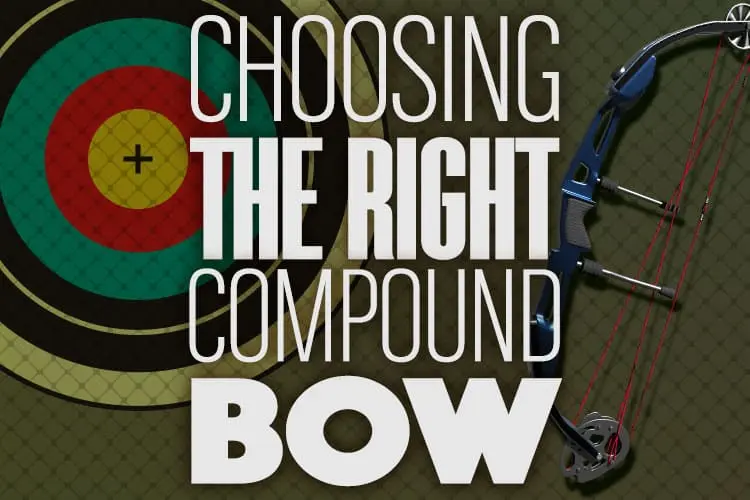
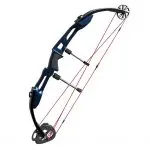
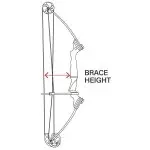

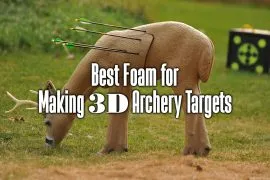

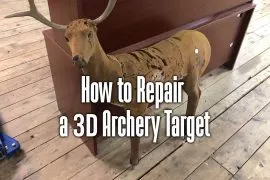
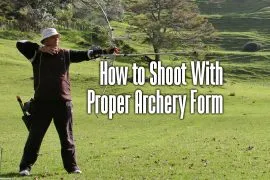

10 Comments
I am looking to buy a compound bow. I was wondering what brands to look at and what price range I should look into.
The best value compound bow is one that suits the archer and his or her needs. After the basics are covered, you should look at each bow’s unique features and decide which one is better suited for your needs. For example, one bow might contain a regular sight where another offers a red dot sight which may help you for dim light applications.
When I first came into archery, I hadn’t a clue about anything. All I know was that I needed my own compound bow (because the local archery range didn’t have any to rent out and that I knew that I had to set it up to suit just me personally)… so naturally I gravitated towards the definition of ‘sexy’ at the time – full camo hunting bows.
Had no idea what axle length, brace height, cam type etc would suit me. All I knew was that the draw length & draw weight had to have a huge range of adjustability so that I was almost guaranteed to be able to shoot it somehow. Turned out it was a good bet!
So I got a cheap Chinese one, the most decent one for what little money I was willing to throw at it. And only in the months of actually shooting the bow (lots of coaching & shooting) could I finally relate to all the info being presented here.
Not before.
I outgrew the bow towards the end of the year. But by then that cheap bow had taught me enough, not just merely in theory but in practical terms, to know exactly what specs I need to look for in my next one.
Pingback: How Heavy is a Compound Bow - Boss Targets Archery Bows
Pingback: Best Morrell's Archery Targets - Boss Targets Archery Target
Pingback: SAS Siege Compound Bow - Boss Targets
Pingback: Bowtech BT-X Compound Bow - Boss Targets
Pingback: Compound or Recurve Bow – Which one is Best and Why?
Pingback: Useful Crossbows fundamentals for Hunters and Target Shooters
Pingback: How to Shoot With Proper Archery Form - Boss Targets